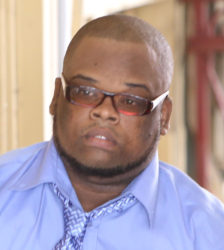Witness for the prosecution, Dirk Bess said that he saw the entire shooting of Ashok Raghoo and his wife, but was never able to make out the shooter during the ordeal which lasted less than two minutes.
Bess was yesterday testifying at the trial of Travis McDougall who is accused of murdering Raghoo during a robbery on the morning of August 18, 2014.
The witness recalled driving south along Vlissengen Road, and bringing his vehicle, to a halt, after the traffic light at the intersection with Regent Street indicated, stop.
He said that the Raghoos drove up and stopped parallel to his vehicle which was second in the line.

Bess said as soon as the vehicles came to a halt, his attention was immediately drawn to the Raghoos’ car after hearing a loud voice exclaim, “give me the bag!”
It was at this point he said, that he saw someone standing outside their vehicle, pointing what appeared to be a gun at Ashok, who was behind the wheel of a red Toyota Marino. The man’s wife, he said was in the front passenger seat.
The witness said he pulled himself back into his seat to view what was happening and saw a scuffle ensue between the driver and the person standing outside the vehicle. He then related hearing an explosion followed by the person stretching into the Raghoos’ vehicle “and tried taking out something.”
During that time, Bess told the court he saw the female occupant of the car hold on to something, screaming, before hearing yet another explosion.
He said that as the person retrieved something from the car, his eyes followed him running with a black bag in a northern direction to someone who was waiting on a motorcycle, shouting “get out of here.”
Bess told the court that he was unable to identify the shooter.
Meanwhile, the prosecution failed to provide video footage which police claimed to have seen, which was of purported evidential value to the case.
Police Detective and Supervising Forensic Video Analyst, Junior Blair, told the court that checks were made to retrieve the CCTV footage in question, but his efforts were fruitless.
The analyst told the court that the police force lacked the capability of retaining that sort of digital data—noting that this was not even done by the Force’s Forensic Video Department itself, located at the Headquarters of the Criminal Investi-gation Department.
He explained to the court, that the Force, even currently, only has the capacity to view footage from cameras around the city, but that the storage capacity lies with the Central Intelligence Unit (CIU), located in the compound of Castellani House.
Back in 2014, Blair said the CIU had the capacity of retaining CCTV for only three months. Currently, he said, that capacity extends to an additional five months.
Under cross-examination by defence attorney Nigel Hughes, Blair agreed that even in light of the shortcomings faced by the police force in retaining the footage beyond a certain period, copies of the footage could have been made.
He also agreed that photos of the video recording could also have been snapped, or even transferred to a flash drive, CD any other portable digital storage device. Blair said that in 2014, his department used only CD’s.
Why these measures were not utilized, the Forensic Video Analyst could not say,
Blair concurred with Hughes, that footage depicting traffic violations are regularly provided to the court in the prosecution of cases. He agreed that murder cases are more serious offences but could not account for why similar steps were not taken to ensure footage relating to Mc Dougall’s case was not preserved.
He could not say why it is that a murder investigation was not given priority.
The witness said too, that he found no evidence of a request being made to the CIU, by police investigators, for footage in the case.
He agreed with Hughes that this is “strange.”
Police Corporal Derwin Eastman in his testimony on Wednesday, could not account for the video footage relating to this case, which he claimed to have seen, causing Justice Navindra Singh to order that the prosecution make every effort to have it presented to the court.
The corporal had conceded Hughes’ suggestion that he has never been able to produce the footage—not even during the preliminary inquiry at the Magistrate’s Court.
Eastman had told the court that he had snapped the footage off the monitor with his cell phone, which has since been damaged.
The trial continues this morning.





